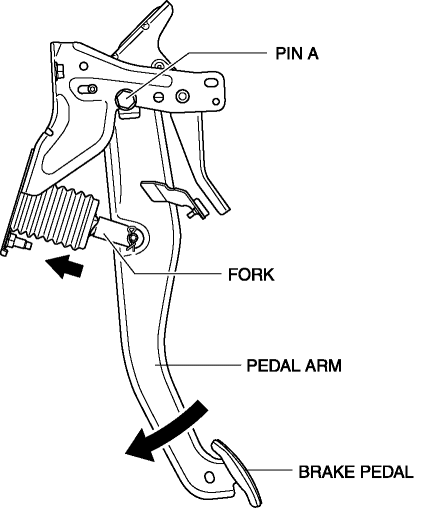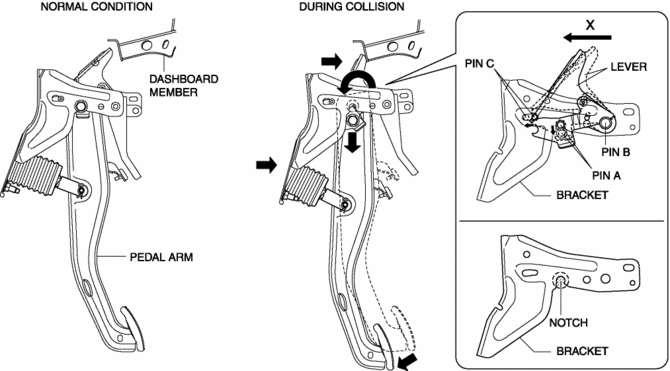Mazda CX-5 Service & Repair Manual: Brake Pedal
Purpose/Function
-
An intrusion-minimizing brake pedal has been adopted to the brake pedal to provide for a measure of safety in the event of an accident.
-
The intrusion-minimizing brake pedal mechanism reduces impact to the lower extremities of the driver by minimizing the amount of rearward brake pedal thrust in a frontal collision.
Construction
-
The intrusion minimizing brake pedal mechanism is structured on the brake pedal and consists of the following parts.
-
Pedal arm
-
Lever
-
Pin A
-
Pin B
-
Pin C
-
Bracket

Operation
During normal braking
-
When the brake pedal is depressed, the pedal arm rotates at the pin A fulcrum point, and the pedal depression force is transmitted to the fork of the power brake unit.
-
This pedal depression force pushes in the fork to operate the brakes.

Intrusion-minimizing operation
-
In a frontal collision, the brake pedal is forced rearward by the movement of the dashboard.
-
In response to this, force in the direction of X is applied to the brake pedal lever because the dashboard member and brake pedal lever interfere.
-
With the addition of force in the direction of X, pin C releases from the lever, and the lever rotates around the pin B fulcrum point.
-
When the lever rotates, it obstructs pin A at the fulcrum point of the pedal arm.
-
If the pedal rotates further, pin A separates from the bracket (notch), and the pedal is freed.
-
By freeing the pedal arm, the force applied to the lower extremities is reduced.

 Brake Hose (Rear) Removal/Installation
Brake Hose (Rear) Removal/Installation
1. Remove in the order indicated in the table.
2. Install in the reverse order of removal.
3. After installation, add brake fluid, bleed the air, and inspect for fluid
leakage..
...
 Brake Pedal Inspection
Brake Pedal Inspection
Pedal Height Inspection
1. Measure the distance from the center of the upper surface of the pedal pad
to the insulator and verify that it is as specified.
If not within the specificatio ...
Other materials:
Driver and Front Passenger Occupant Classification System
First, please read “Supplemental Restraint System (SRS) Precautions” carefully.
Driver Seat Slide Position Sensor
Your vehicle is equipped with a driver seat slide position sensor as a part of
the supplemental restraint system. The sensor is located under the driver seat.
The sensor ...
Transfer Oil Inspection [Fw6 Ax EL]
1. Park the vehicle on level ground.
2. Remove the oil level plug with the washer.
3. Checking by hand, verify that the oil is near the brim of the plug hole.
If the oil level is low, add the specified amount and type of oil through
the oil level plug hole.
Transfer oil
...
Sas Control Module Configuration (Using As Built Data) [Standard Deployment
Control System]
NOTE:
If the configuration is performed using As-Built data, the set value of the
personalization function is reset to the initial value (condition when shipped
from factory). Verify the set value with the customer and perform the personalization
function setting after performing th ...
